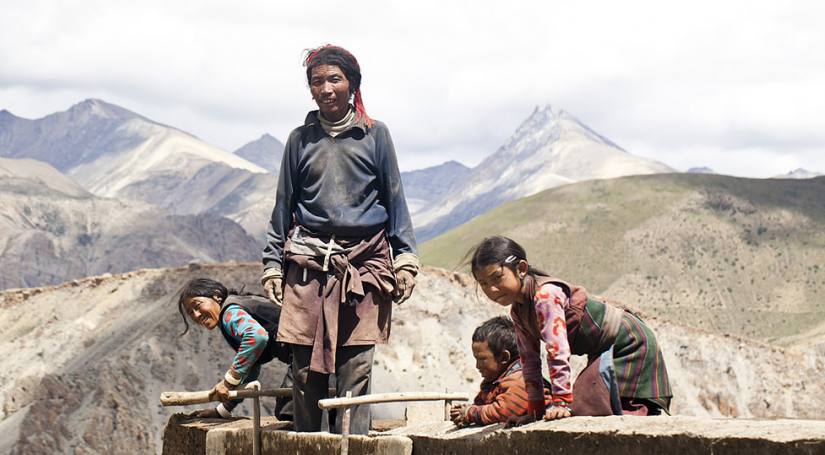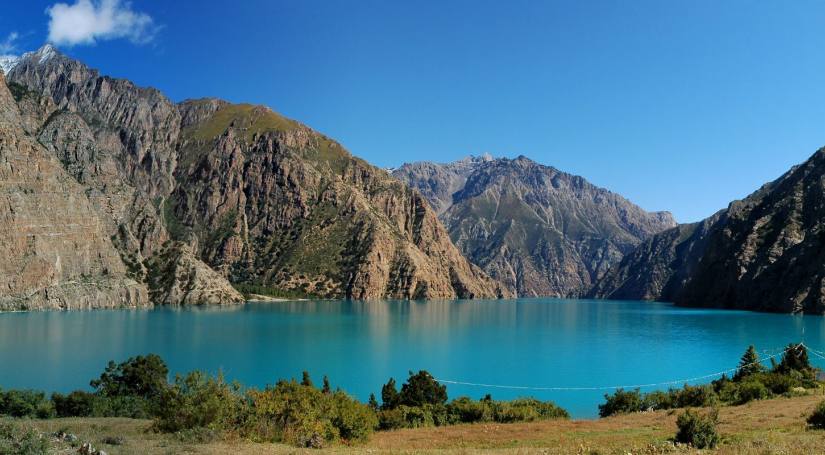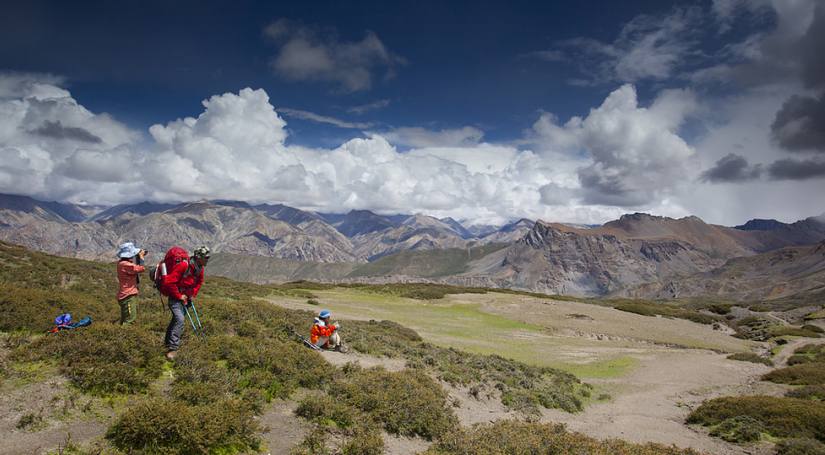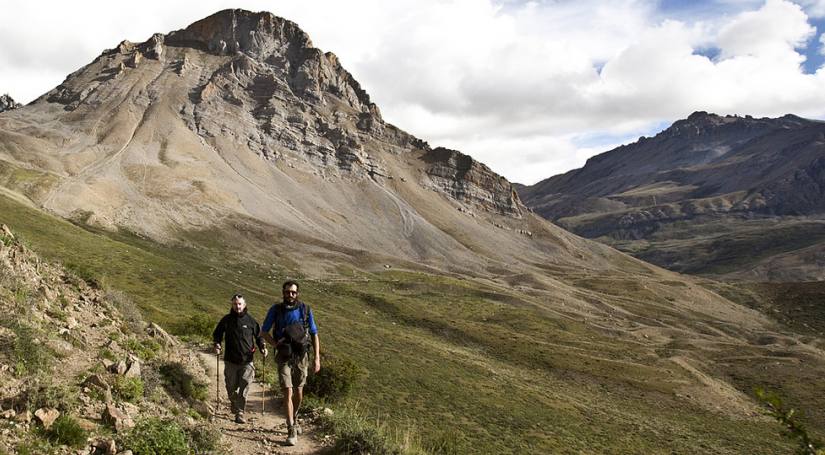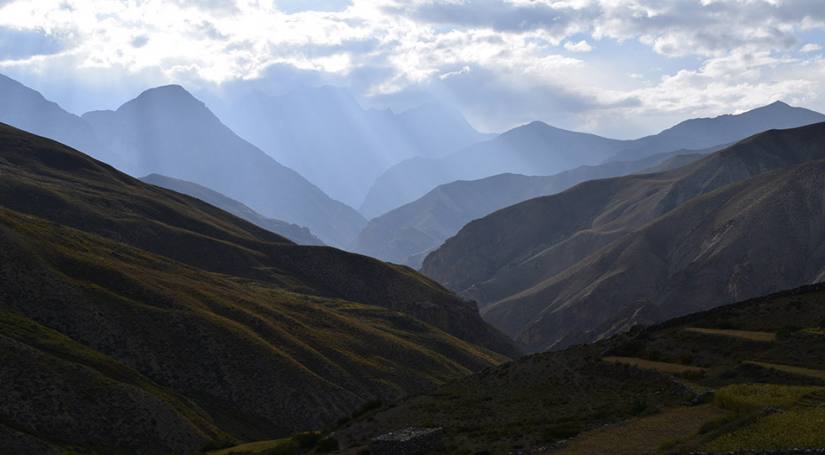Upper Dolpo Trek - 28 Days
-
Trip Code HTA-24
-
Duration: 28 Days
-
Trip Grade Moderate
Trip Highlights
Upper Dolpa Highlights:-
- Phoksundo Lake
- Highland monasteries including the one at Shey
- Bon culture at Ringmo, the village just above Phoksundo Lake
- Nomads of the ancient trading town, Dho
About Trip:
Upper Dolpa Trek:
The Dolpo region lies between the Tibetan Plateau and the Dhaulagiri range. Closed to travelers until 1989, the southern part of Dolpo later opened for organized trekking groups. Our journey begins with a visit to a UNESCO World Heritage Site in Kathmandu, followed by a flight to Nepalgunj and onward to Juphal, where we commence our trek in this remote region. Dolpo is famously featured in Peter Matthiessen’s book The Snow Leopard and was the setting for the first English-language Nepali film, Dolpo, The Caravan, which was also nominated for an Oscar for Best Foreign Language Film.
Over the course of our 28-day trek, we pass through fascinating villages, rugged trails, and meet warm, welcoming locals. The route takes us across some of the highest Himalayan peaks and offers the serene beauty of Pokhundo Lake. Following the historic Himalayan trade routes, we eventually return to Juphal, concluding our journey into the wild west of Nepal.
Outline Itinerary
| S.N.:- | OUTLINE ITINERARY:- |
| Day-01(1,350m.) | Step on Kathmandu |
| Day-02(1,350m.) |
UNESCO WORLD HERITAGE (SIGHTSEEING) |
| Day-03(150m.) | Nepalgunj Flight, 1 hr. |
| Day-04(2,850m.) | Dolpa(Jhupal) Flight, Dunai Trek,2-3 hrs. |
| Day-05(2,896m.) | Ankhe,5-6 hrs. |
| Day-06(3,180m.) | Sulighat,5-6 hrs. |
| Day-07(3,611m.) | Phoksundo Lake |
| Day-08(3,611m.) | Phoksundo Lake Acclimatization |
| Day-09(3,507m.) |
Phoksundo Khola, 4-5 hours |
| Day-10(3,910m.) | Phoksundo Bhanjyang,6-7 hours |
| Day-11(5,360m.) | Shey Gompa via Kang-La pass,5-6 hours |
| Day-12(5,360m.) | Shey Gompa Rest/Acclimatization |
| Day-13(5,200m.) | Namduna Gaun via Saldang La,6-7 hours |
| Day-14(3,620m.) | Saldang,4-5 hours |
| Day-15(4,960m.) | Yangze Gompa,4-5 hours |
| Day-16(4,560m.) | Sibu, 6-7 hrs. |
| Day-17(4,900m.) | Jeng-la Phedi,5-6 hrs. |
| Day-18(5,090m.) | Tokyu Gaon via Jeng La Pass |
| Day-19(4,040m.) | Dho Tarap,4-5 hrs. |
| Day-20(4,040m.) | Dho Tarap Rest |
| Day-21(3,800m.) | Tarap Khola (Kamakharka),6-7 hours |
| Day-22(3,150m.) | Khanigaon,4-5 hrs. |
| Day-23(2,537m.) | Tarakot,4-5 hrs. |
| Day-24(2,140m.) | Dunai,5-6 hours |
| Day-25(2,850m.) | Jhuphal,2-3 hrs |
| Day-26(1,350m.) | Nepalgunj Flight then fly Kathmandu |
| Day-27(1,350m.) | Rest Day in Kathmandu |
| Day-28(1,350m.) | Final Departure |
Cost Includes:
- Airport pickups and drops in a private vehicle
- Star level hotel accommodation in Kathmandu with breakfast
- Teahouse accommodation during the trek
- All meals (breakfast, lunch, and dinner) during the trek
- Welcome Dinners
- All ground transportation on a comfortable private vehicle as per the itinerary
- Domestic flights
- Guided city tour in Kathmandu by private vehicle
- Entrance fees for sightseeing/monument visits as per the itinerary
- An experienced English-speaking trek leader (trekking guide), and Sherpa porters to carry luggage including their salary, insurance, equipment, flight, food, and lodging
- Staff costs including their salary, insurance, equipment, domestic airfare, food, and accommodation
- Himalayan Traverse’s trekking bag/duffel bag
- All necessary paperwork and trekking permits (National Park Permit, TIMS)
- All government and local taxes
Cost Excludes:
- Nepalese visa fee
- Excess baggage charge(s)
- Extra night accommodation in Kathmandu because of early arrival, late departure, early return from mountain (due to any reason) than the scheduled itinerary
- Lunch and evening meals in Kathmandu
- International flights
- Travel and rescue insurance
- Personal expenses (phone calls, laundry, bar bills, battery recharge, extra porters, bottle or boiled water, shower, etc.)
- Tips for guide(s), porter(s) and driver(s)
Trip Map
Day-01: Step on Kathmandu(1,350M./4,429FT.)
Upon arriving in Nepal, we complete the necessary customs formalities at Tribhuvan International Airport, Kathmandu. A Himalayan Traverse representative will warmly welcome you at the gate and escort you to your hotel. The rest of the day is free to rest and recover from the long flight.
✈1,350m.
☾Hotel Vaishali
〄No Meal
Day-02: UNESCO WORLD HERITAGE SIGHTSEEING(1,350M./4,429FT.)
Explore four major landmarks and three UNESCO World Heritage Sites in Kathmandu with the guidance of a professional licensed guide. Visit Swayambhunath and Boudhanath Stupas, Pashupatinath Temple, and Kathmandu Durbar Square, gaining a deeper understanding of the city’s history. In the evening, enjoy a warm welcome dinner hosted by Himalayan Traverse, featuring traditional Nepalese cuisine, where you can meet the team and get to know your guides personally.
Overnight stay in Kathmandu.
INCLUDED MEALS: WELCOME DINNER
✈1,350m.
☾Hotel Vaishali
〄Breakfast, Welcome Dinner
Day-03: Nepalgunj Flight, 1 hr.
We begin the day with a one-hour flight from Kathmandu to Nepalgunj in western Nepal. Located near the Nepal–India border, Nepalgunj serves as the gateway to Simikot and the Humla region. This vibrant Terai town showcases diverse cultures and traditions. During our visit, we explore the local market, a mini-zoo, and nearby villages.
Overnight stay in Nepalgunj.
INCLUDED MEALS: BREAKFAST, LUNCH & DINNER
✈150m.
☾Hotel/Tea-House
〄Breakfast, Lunch & Dinner
Day-04: Nepalgunj Flight to Jhuphal (Dolpo) & Dunai (2,850m/9,348ft) trek: 45 mins flight, 2-3 hr. s trek
After breakfast, we took a flight to Jhupal, a city perched at one of the highest points in the Himalayas, offering stunning views of the Annapurna and Dhaulagiri ranges to the north. Upon arrival, we met our tour guides and began our adventure. The journey then crossed the plains toward the Beer River and its narrow gorge. Later, we proceeded to Dunai, the administrative center of Dolpo. In the evening, we explored a small village before setting up our tents for the night.
INCLUDED MEALS: BREAKFAST, LUNCH & DINNER
✈2,850m.
☾Hotel/Tea-House
〄Breakfast, Lunch & Dinner
Day-05: Ankhe (2,896m/9,499ft), 5-6 hr. s
We crossed the suspension bridge and followed the path westward, passing the hospital. The trail climbed along the edge of the treeless Thuhulu Bheri Valley before entering the Poxundo River Valley. Along the way, we caught sight of Kagmara Peak towering above the valley. The route took us past clusters of dye trees, through the villages of Dhera and Rahagaun, and across dense jungle, until we finally arrived at Ankhe, where we spent the night.
INCLUDED MEALS: BREAKFAST, LUNCH & DINNER
✈2,896m.
☾Hotel/Tea-House
〄Breakfast, Lunch & Dinner
Day-06: Sulighat, 5-6 hr. s
Our journey led us along the riverbank, with climbs up hills and descents down slopes. Although going downhill can be exhausting, numerous streams along the way offered refreshing spots to cool off. The trail eventually emerged from the forest onto a grassy slope overlooking the river. We navigated a steep descent surrounded by dense vegetation, reached a cliff, and then carefully descended to the riverbank. Continuing onward, we finally arrived at Sulighat, where we stayed for the night.
INCLUDED MEALS: BREAKFAST, LUNCH & DINNER
✈3,180m.
☾Hotel/Tea-House
〄Breakfast, Lunch & Dinner
Day-07: Phoksundo Lake (3,611m/11,849 ft),4-5 hr. s
We continued our journey toward the confluence of the Phoksundo and Pungmo Rivers. After crossing a bridge, we followed the west bank of the Pungmo Khola. The trail led us through a cedar forest before opening into the Palm Valley. From there, we climbed along the river, enjoying expansive views of Phoksundo Lake and a stunning waterfall, one of Nepal’s highest. The path then descended through birch forests to the areas above Phoksundo Khola, eventually reaching the scenic Ringmo region, known for its distinctive mud-walled houses. From Ringmo, it was a short walk to the shores of Lake Phoksundo, where we spent the night at His Fountain.
INCLUDED MEALS: BREAKFAST, LUNCH & DINNER
✈3,611m.
☾Hotel/Tea-House
〄Breakfast, Lunch & Dinner
Day-08: Phoksundo Lake Acclimatization/Rest
Today promises to be a wonderful day to explore Phoksundo Lake. Around noon, we set out on a short trip to the town of Ringmo and its Tibetan monastery. During this excursion, we had the chance to observe local customs. The people of Dolpo typically wear brown traditional attire and favor Tibetan embroidery styles. For footwear, they often use dhocha—boots with flexible toes. Both men and women commonly adorn themselves with coral, amber, and turquoise jewelry. We returned to His Fountain for the night.
INCLUDED MEALS: BREAKFAST, LUNCH & DINNER
✈3,611m.
☾Hotel/Tea-House
〄Breakfast, Lunch & Dinner
Day-09: Phoksundo Khola, 4-5 hr. s
Our trail followed the upper western edge of Lake Phoksundo, skirting the rocky shoreline. A wooden walkway supported by concrete slabs marked the path ahead and the distance we were about to cover. At the lake’s western end, the route opened into a lush green pasture that led into the Phoksundo Khola floodplain. From there, we continued through the valley, crossed the river, bypassed a temporary gorge on foot, and finally reached the riverbank, where we set up camp for the night.
INCLUDED MEALS: BREAKFAST, LUNCH & DINNER
✈3,507m.
☾Hotel/Tea-House
〄Breakfast, Lunch & Dinner
Day-10: Phoksundo Bhanjyang, 6-7 hr. s
About an hour later, we made our way toward the snow-covered northern cliffs. At the junction of Phoksundo Khola and a mountain stream, we crossed an old wooden bridge. From there, we headed northeast, climbing a steep slope that led to a sheepfold and then into a gorge. The ascent to the summit brought us to another valley, offering views of the Kang-La pass. We set up camp in the area famously named “Snowfields Camp” by Peter Matthiessen. Throughout the day, we enjoyed breathtaking views of Chhamlang Peak (6,739 m) and Peak 7 (6,105 m).
INCLUDED MEALS: BREAKFAST, LUNCH & DINNER
✈3,910m.
☾Hotel/Tea-House
〄Breakfast, Lunch & Dinner
Day-11: Shey Gompa (4,500m/14,760ft) via Kang-La pass (5,360m/17,581ft), 5-6 hr. s
In the morning, we began our climb up the mountain toward the cross. Reaching the summit was challenging, but from there, passing Kang-La, we were rewarded with spectacular views of a vast valley carved by a winding river. We then descended into the valley and followed a path along the riverbank, crossing it several times. The hills along the river were dotted with mud caves, and we passed pastures where yaks grazed alongside hundreds of goats (Chyangra). After crossing an old wooden bridge, we arrived at the Shey Gompa complex, where we stayed for the night.
INCLUDED MEALS: BREAKFAST, LUNCH & DINNER
✈5,360m.
☾Hotel/Tea-House
〄Breakfast, Lunch & Dinner
Day-12: Shey Gompa Acclimatization/Rest
Shey Gompa, built in 1655, is renowned for its large bronze palace and a gold-plated statue of Shakyamuni Buddha. To the east of the lake stands Crystal Mountain, famed for its stunning cliffs made of quartz interspersed with various types of sea coral. Today was a well-deserved day of rest and acclimatization. We spent the day hiking around Shey, a town celebrated for its ancient pre-Buddhist Bon Po culture. In Dolpo, the traditional Tibetan practices blend animism with Buddhist teachings. We stayed overnight at Shey Gompa.
INCLUDED MEALS: BREAKFAST, LUNCH & DINNER
✈5,360m.
☾Hotel/Tea-House
〄Breakfast, Lunch & Dinner
Day-13: Namduna Gaun (4,800m/15,744ft) via Saldang La (5,200m/17,056ft), 6-7 hrs.
We began the day walking along a scenic plateau dotted with juniper trees. The trail then wound over bare rocks and eroded soil, eventually leading us to the summit past Saldang-la. The descent to the north was long and tiring, but the sight of yaks, sheep, and nomadic tents made of yak hair offered comfort along the way. In Namduna Gaun, we visited the Namgung Palace, a red structure built against a stone wall on the north side of the gorge. We spent the night in Namduna Gaun.
INCLUDED MEALS: BREAKFAST, LUNCH & DINNER
✈5,200m.
☾Hotel/Tea-House
〄Breakfast, Lunch & Dinner
Day-14: Saldang (3,620m/ 11,874ft), 4-5 hr. s
Leaving the town, we climbed a steep slope to begin a long trek through the dusty mountains. After a three-hour hike, we reached Saldang Village, situated on a high plateau above the Namga Khola River. Saldang is the largest settlement in central Dolpo, stretching about two miles (2 km) along the open slope and comprising five smaller villages with roughly eighty well-built houses and around 600 residents. The village thrives not only through agriculture but also due to its strategic location on the trade route to Tibet. We stayed overnight in Saldang.
INCLUDED MEALS: BREAKFAST, LUNCH & DINNER
✈3,620m.
☾Hotel/Tea-House
〄Breakfast, Lunch & Dinner
Day-15: Yangze Gompa (4,960m/16,267ft), 4-5 hr. s
From Saldang, we continued north along the Nagon Khola road, moving through a barren and desolate landscape. Our pace was slow as we traveled, passing through the villages of Marang and Ki. We then crossed a canal flowing from the Panzang River and traversed the river itself before arriving at Yangze Gompa, home to the historic Bon-Po palace. We spent the night at Yangze Gompa.
INCLUDED MEALS: BREAKFAST, LUNCH & DINNER
✈4,960m.
☾Hotel/Tea-House
〄Breakfast, Lunch & Dinner
Day-16: Sibu (4,560m/14,957ft), 6-7 hr. s
From Yangze, there are two routes to reach Sibu. To save time, we chose the route back through Saldang, which proved easier and shorter. From Saldang, we crossed the river, passing through swampy fields, stupas, chortens, piles of stones, and the Chaiba Palace. We then entered the thriving village of Namdo, home to about 60 houses and roughly 400 residents, stretching over 5 km along the main slopes to the left of Nam Khong Khola. Namdo’s monastery sits close to the river. Continuing along the river for another two hours, we finally camped near the small town of Sibu.
INCLUDED MEALS: BREAKFAST, LUNCH & DINNER
✈4,560m.
☾Hotel/Tea-House
〄Breakfast, Lunch & Dinner
Day-17: Jeng-la Phedi (4,900m/16,072ft), 5-6 hr. s
We drove along Nam Khong Khola for a while before beginning a yak trek toward the Tibetan border. After a short journey eastward, we arrived at the confluence of two streams. From there, the steep trail ascended toward the settlements below Jeng La Pass (4,900 m / 16,072 ft). We set up camp in a picturesque pasture at Jeng La Phedi for the night.
INCLUDED MEALS: BREAKFAST, LUNCH & DINNER
✈4,900m.
☾Hotel/Tea-House
〄Breakfast, Lunch & Dinner
Day-18: Tokyu Gaon (4209m/13809ft) via Jeng La pass (5,090m/16,695ft), 5-6 hr. s
We woke up early to begin our journey for the day. After about two hours, we reached the summit of Jeng La, where we were treated to spectacular views of the northern face of the Dhaulagiri River. From the summit, we descended along the ridge into the Tarap Valley, a stunning area featuring vast plateaus stretching 12 miles (20 km) along the Tarap Chu River. We set up our tents near Tokyu Monastery for the night.
INCLUDED MEALS: BREAKFAST, LUNCH & DINNER
✈5,090m.
☾Hotel/Tea-House
〄Breakfast, Lunch & Dinner
Day-19: Dho Tarap(4,040m/13,251ft): 4-5 hr. s
We descended steep slopes along both sides of the river, a landscape strikingly different from the rest of inner Dolpo. The area also features swamps, a common characteristic of the Tibetan and Ladakh Himalayan deserts. Both Bon Po and Buddhist communities are present in this valley. After a short drive, we reached Dho Tarap, where we spent the night.
INCLUDED MEALS: BREAKFAST, LUNCH & DINNER
✈4,040m.
☾Hotel/Tea-House
〄Breakfast, Lunch & Dinner
Day-20: Dho Tarap Rest Day
Today was a day of rest and exploration in the valley of Dho Tarap, surrounded by distinctive stone walls. Our time here allowed us to observe local customs. The village of Dho consists of about 40 houses, divided into three clusters, reflecting a style unlike that of the few Tibetan residents, particularly the Magars, a mountain tribe of Nepal. While in the area, we had the option to visit the Buddhist Gompa near our camp or take a 40-minute walk to the Bon Po Gompa. We spent the night in Dho Tarap.
INCLUDED MEALS: BREAKFAST, LUNCH & DINNER
✈4,040m.
☾Hotel/Tea-House
〄Breakfast, Lunch & Dinner
Day-21: Tarap Khola (Kamakharka) (3,800m/12,464ft), 6-7 hr. s
From Tarap, we descended through a wide valley that eventually narrowed into a gorge. The trail passed through areas dotted with juniper and wild roses just above the tree line. Along the way, we spotted herds of blue sheep. By the afternoon, we reached the confluence of the Tarap Chu and Lang Khola, a river that joins the Tarap River in the far east. We set up camp on the scenic plains of Kamakharka and spent the night there.
INCLUDED MEALS: BREAKFAST, LUNCH & DINNER
✈3,800m.
☾Hotel/Tea-House
〄Breakfast, Lunch & Dinner
Day-22: Khanigaon(3,150m/10,332ft), 4-5 hr. s
We continued down the Tarap River, occasionally following the riverbank. Along the way, we encountered local people moving their herds to the lowlands for the winter. This was one of the most thrilling days of the journey, as the valley narrowed into a deep gorge where, in some spots, we had to leap from one side to the other. In certain areas, the trail disappeared, forcing us to walk over stone slabs lined with logs acting as makeshift bridges. The gorge offered both unexpected challenges and moments of excitement. In some places, damaged or washed-away bridges required us to cross the cold river on foot. Finally, we reached our camp near Tarap Khola in Khanigaon for the night.
INCLUDED MEALS: BREAKFAST, LUNCH & DINNER
✈3,150m.
☾Hotel/Tea-House
〄Breakfast, Lunch & Dinner
Day-23: Tarakot (2,537m/8,321ft), 4-5 hr. s
Leaving our camp, we followed the trail toward the village of Lalberi. The route took us through dense jungle, down a gorge, and along the river. Upon reaching Tarakot, we had the opportunity to visit Sandile Gompa, located about five miles (8 km) east of town, where the Barbung Khola meets the Tarap Chu. The monastery sits on the southern bank of the Bear River. For the night, we camped along the Tarap Chu River, roughly 150 meters below Tarakot, near the local police post.
INCLUDED MEALS: BREAKFAST, LUNCH & DINNER
✈2,537m.
☾Hotel/Tea-House
〄Breakfast, Lunch & Dinner
Day-24: Dunai (2,140m/7,019ft), 5-6 hr. s
We began our journey following the Beer River, crossing a bridge near the town of Lawan. The trail continued along the river toward Basas Gadi and then headed westward. We crossed the river again at Lochakhola Gaon before ascending to Dunai, where we spent the night. Today’s trek took us through a beautiful gorge adorned with pine trees. Overnight stay was in Dunai.
INCLUDED MEALS: BREAKFAST, LUNCH & DINNER
✈2,140m.
☾Hotel/Tea-House
〄Breakfast, Lunch & Dinner
Day-25: Jhuphal, 2-3 hr. s
Leaving Dunai, we followed the Beri River, taking in the scenic surroundings. Along the way, we passed the villages of Dhupichaur and Rupgad, as well as a local temple. Continuing on, we reached Kalagaonda and the village of Motipur before arriving at the small airport. We spent the night in Jufal.
INCLUDED MEALS: BREAKFAST, LUNCH & DINNER
✈2,850m.
☾Hotel/Tea-House
〄Breakfast, Lunch & Dinner
Day-26: Jhuphal Flight to Nepalgunj & Kathmandu Flight
We took the earliest flight to Nepalgunj, followed by the next available flight back to Kathmandu, where we were transferred to our hotel. The afternoon was free to catch up on emails with fellow travelers and organize our photos. To celebrate the successful completion of our journey, a farewell dinner was hosted by Himalayan Traverse. Overnight stay was in Kathmandu.
INCLUDED MEALS: BREAKFAST
✈1,350m.
☾Hotel/Tea-House
〄Breakfast
Day-27: Kathmandu Rest day
This extra day is reserved for exploring Kathmandu at your own pace. You can use the time to prepare for your next flight, shop for souvenirs, or visit any place in the city you’ve been eager to see, with Himalayan Traverse available to help arrange it. Overnight stay is in Kathmandu.
INCLUDED MEALS: BREAKFAST
✈1,350m.
☾Hotel/Tea-House
〄Breakfast
DAY-28: FINAL DEPARTURE
Today marks the farewell of our journey together. We hope to welcome you back to Nepal for another adventurous trip in the future. You will be taken to the international airport three hours before your scheduled flight, marking the start of your journey back home. Overnight stay is in Kathmandu.
INCLUDED MEALS: Breakfast
✈1,350m.
☾Homeland
〄Breakfast
(Note: Booking must be confirmed 6 months before in advance)
You must bring the important documents mentioned below in your trip.
- Valid Passport with 2 pp sized photos
- Proof of insurance and visa form
- International air tickets
- Enough cash which can be exchanged once you reach Kathmandu
- Credit cards, Bank/ATM/Cash machine cards for withdrawing funds from cash machines (bring a photocopy of your cards), traveler's checks, etc.
You May Also Like
Trek to Langtang
We first met Dorjee Sherpa in 2012 and did a trek with him to Langtang before it was devastated in the earthquake. We quickly fell in love with the himalayas, the Nepalese people, their culture, and Dorjee shepa. The Langtang trek was a beautiful trek and a great introductory to the…
 Matt massey, United StatesDecember 16, 2025
Matt massey, United StatesDecember 16, 2025
Trek to Tyangboche
Just got home from our second trek in the Himalayas with Dorjee sherpa. We treked to tengboche for the mani rimdu festival. The festival was incredible and the mountains are magnificent. Dorjee is a great guide and we really enjoyed staying at his Buddha lodge and meeting his wonderful family.
 Matt massey, United StatesDecember 16, 2025
Matt massey, United StatesDecember 16, 2025
Mani Rimdu Festival trek
My family and friends from Maui completed a 10 day trek through Sagarmatha National Park to Tengboche to view the Mani Rimdu Festival in November . Our Guide Dorjee Sherpa and his associates arranged a fantastic trip for us. We stayed at his Buddha Lodge in Phakding and were treated very…
 Kevin Horan, NepalDecember 16, 2025
Kevin Horan, NepalDecember 16, 2025
Have fun with trust!
I spent very memorable days in the Everest region in Nepal. I used to dream to see this highest peak of the world and now I arrested it in my camera. My guide arranged everything and helped me a lot. He did not let me feel tired and boring.
 Austin, Netherlands AntillesDecember 16, 2025
Austin, Netherlands AntillesDecember 16, 2025
Certificate & Partners





